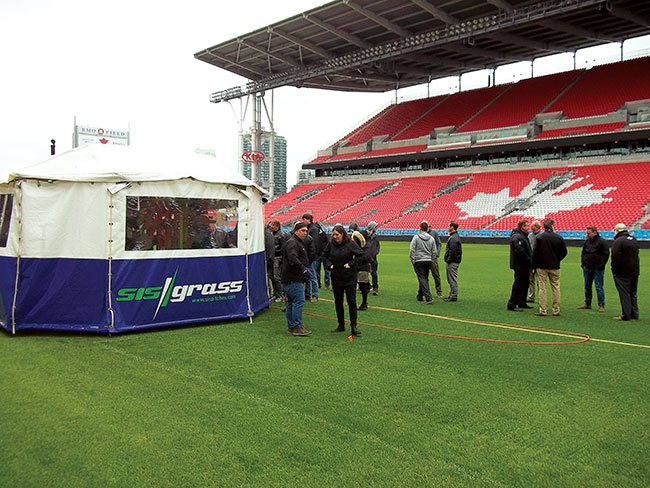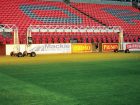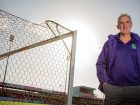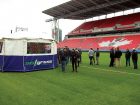
News
Sports turf
Turf Care Equipment
BMO Field’s new hybrid turf surface
It’s still 95 per cent natural turf, but stitched-in fibres will give field more wear tolerance, playability
May 15, 2019 By Mike Jiggens

May 15, 2019 – Toronto’s ever-evolving BMO Field has taken yet another giant step forward. It’s not something that fans of the Toronto FC or Toronto Argonauts are likely to notice, nor is it something that will be readily apparent to the players of both teams. But head groundskeeper Robert Heggie and his staff are going to see and appreciate the difference.
In mid-April, the field that is home to Major League Soccer’s Toronto FC club and the Canadian Football League’s Argonauts adopted a new turf system expected to reduce the amount of field wear – especially during both teams’ shoulder seasons – and provide more consistent playability for its two primary user groups.
A hybrid system now exists on the field located at the site of the former Exhibition Stadium on the city’s lakeshore. It’s still essentially a full natural turf surface – estimated at about 95 per cent – but stitched-in artificial fibres have been introduced to give it greater wear tolerance and playability.
Speaking on site at Sports Turf Canada’s spring industry forum and annual general meeting in April, Heggie told delegates it has become increasingly more challenging to grow and maintain grass when the playing seasons span into non-traditional growing months, including February, March, November and December.
“Literally, I’m growing grass on this field 12 months of the year,” he said.
In spite of a SubAir heating system installed beneath the surface in 2010 and an array of portable grow lights, the turf still has limitations during the winter.
“We found out we can germinate grass and grow grass,” he said. “We just can’t make the roots really dive until we get past April.”
This presented problems when the FC club’s season began as early as February. The current season’s home opener played in late February was “pretty rough” yet was successful from an agronomic perspective, Heggie said. From the players’ standpoint, however, it was deemed “a disaster” because the field didn’t play the way they wanted it to play. He said professional soccer players don’t care what month it happens to be or how cold it is or if they were wearing parkas just prior to the start of the game, they want to know, “Why isn’t the grass perfect?”
Heggie looked into new technologies that could help with root zone reinforcement during the soccer and football shoulder seasons and realized a hybrid system would help protect the existing asset. But first he needed to sell the idea to Maple Leaf Sports & Entertainment (MLSE), operator of the city-owned field.
“The grass doesn’t want to grow at those times of the year and we’re stressing it out.”
In his appeal for the necessary funding for a hybrid system, Heggie said many of the MLSE board members didn’t understand the intricacies of root development and other agronomic matters, but an informative slide presentation proved convincing.
“It made sense why we needed to reinforce that root zone.”
MLSE injected another $2 million into the betterment of the field, but Heggie said the hybrid system didn’t account for the bulk of the investment. Much of the cost included upgrades to the irrigation, SubAir and hydraulic systems before work began to produce the hybrid system. He said it was important that holes weren’t being dug into the field after the stitching had begun.
Additional grow lights
A large chunk of the $2-million investment covered the need for additional grow lights. The stadium now has nine large rigs and six small rigs, allowing for about 65 per cent of the field to be bathed in artificial lighting and heat. Previously, BMO Field was equipped with six large rigs of grow lights and two small rigs.
Heggie said one of the intents of the hybrid system is to better control thatch and organic matter, adding he is also through with ride-on mowers.
“A ride-on mower will never go back on that field.”
He has switched to Cub Cadet’s InfiniCut walk-behind mowers, which he said have become the global standard at stadium settings, even if they haven’t fully caught on yet in North America.
“You do not ride a 3,000 or 2,000-pound machine when you could be doing this.”
Heggie said mowing the field with the InfiniCut mowers is not a significant consumption of time. Two individuals can double-cut the field in about 3½ to four hours using the walk-behinds.
One of the more pleasing aspects associated with the hybrid renovation project is the vastly improved irrigation system, he said. An undersized irrigation system was in place the past nine years, putting out 65 gallons of water a minute, but only one head at a time could be used from the 15 heads. The upgrade to a six-inch feed and four-inch mainline – from an original 2½-inch mainline – increased the water volume to 480 gallons a minute.
“At halftime, the field gets nice and wet, the players are happy and I’m happy.
Stitching the artificial turf fibres into BMO Field’s existing profile was the icing on the cake, Heggie said, adding the playing surface is still 95 per cent natural.
“The players won’t even know it’s there.”
The company hired to install the hybrid system was U.K.-based SIS Pitches. The company was founded in the Netherlands in 2001, building natural turf sports pitches, and later evolved into the United Kingdom with a synthetic turf factory before moving into hybrid systems. CEO George Mullan said the company’s background has always been in the design/build of natural grass pitches.
“I’m very much a natural grass guy,” he said.
SIS Pitches has completed various hybrid turf stitching projects around the world, not only for soccer field applications but golf tees, lawn tennis courts and cricket wickets. Perhaps its most notable accomplishment was the stitching of six of the 12 World Cup stadium pitches in 2018, including Moscow’s Luzhniki Stadium that served as the venue for the soccer tournament’s final match as well as the opening and closing ceremonies.
The stadium’s playing surface endured 84 hours of use over 35 days.
“When you have an audience of one and a half billion, you just cannot afford a mistake. That’s the principal advantage of a hybrid stitched system. It’s an insurance policy. It works very, very well in high wear areas.”
Mullan said if the stadium had to go alone with its strictly natural surface, it wouldn’t have survived through the quarter final round.
Because the hybrid pitches are 95 per cent natural grass, “they have to be maintained as a natural grass pitch,” he said.
Stitching of fibres
Artificial fibres are stitched about 7½ inches into the profile with about .8 inches sitting above the surface, although the length of fibre above ground will depend on the sport. A shorter length of fibre will be above the surface on golf tees, for example. Laser guidance is utilized for greater accuracy.
The fibres are two-tone, soft polyethylene filaments that provide player comfort and blend into the natural turf. They stand up straight following annual renovation.
SIS Pitches currently has five stitching machines and another entirely electric machine ready to go online in late May. The existing machines are mostly electric, designed especially to avoid oil leaks on the playing surface. The units resemble giant sewing machines that can stitch artificial fibres into a full-size soccer field in about seven days. The company has rendered the machines to be more efficient in recent years, reducing the stitching time by about three days.
Each machine cost about half a million Euros to build. In addition to the large machines, a smaller electric unit has been designed for smaller surface areas such as golf tees, cricket wickets and soccer goalmouths and sidelines.
Mullan said SIS Pitches prefers to stitch fibres into existing fields that have been seeded for at least three or four weeks. Stitching can be done in sand, but he said it requires the use of multiple needles. Although the stitching machines have wide tracks, a little surface disruption will still occur.
Some renovation work is apt to be required prior to stitching, including removal of thatch, sanding and overseeding. About 25 fields in the United Kingdom were in the process of being renovated at the time of BMO Field’s conversion. Mullan said they were being stripped, sanded and overseeded with play expected to resume by mid-July.
Mullan said his company’s fastest-growing market is cricket. Most of England’s top clubs have been converted to a hybrid system and are realizing two to 2½ times more usage.
SIS Pitches has stitched in about 100 sports fields since the hybrid system entered the market in 2015, including the National Football League’s Lambeau Field – home of the Green Bay Packers. Other projects have recently been done in China, Turkey and Australia.
About BMO Field
BMO Field was constructed in 2006 at a cost of $62.9 million, funded by the three tiers of government and MLSE. It was originally constructed with an artificial playing surface, but the Toronto FC club found it couldn’t attract high-end players as long as the field remained synthetic. A decision was made in the winter of 2009-2010 to convert the stadium to natural turf.
With the conversion to natural turf, a SubAir heating system was installed. The playing surface is essentially a USGA system with 12 inches of sand in a 90-10 mix.
Originally built to seat 22,000 spectators, a canopied grandstand addition and seating for another 12,000 spectators were completed in 2014-2015 to accommodate the Toronto Argonauts. End zones were constructed on the field for football.
The addition of the grandstand canopy partially blocked the sun’s energy, requiring grow lights to be used on the field between games. This was especially important to facilitate field repairs for the more aggressive football games.
Print this page


